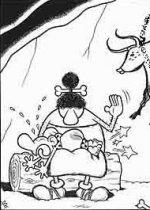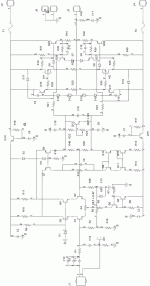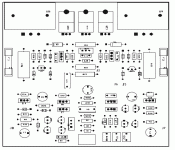lumanauw said:...
This design has single differential, and pushpull VAS. The levelshifter is done by folded cascode. (leading to low openloop gain) The output of right differential is converted to drive lower VAS transistor with current mirrors. This is from AD817 opamp.
Can anyone help, if I want to make this design an audio power amp, what is the bias current for Differential, Folded cascode, and final transistor? The supply is about +/-50V.
Where are the VAS transistors in this design? This is a folded cascode (all the gain is in this one stage!), followed by a complementary buffer. I don't think a complementary buffer will work too well as an output stage in a power amp.
Frank,
How can a cascoded JFET have higher gain then a non cascoded JFET?
Or am I missing something...
How can a cascoded JFET have higher gain then a non cascoded JFET?
Or am I missing something...

I've AD817 version for power amp
Hi, lumanaw...
You asked for AD 817 version for power amp application. I've built that and tested succesfully. It based on differential folded cascode with local feedback. It has about 100 W (8ohm). The result make me happy. If you interest you may contact me..
cheeers,
Lukio
Hi, lumanaw...
You asked for AD 817 version for power amp application. I've built that and tested succesfully. It based on differential folded cascode with local feedback. It has about 100 W (8ohm). The result make me happy. If you interest you may contact me..
cheeers,
Lukio
HE SAID WHAT???????
Cascode increases gain????????????? Really????
You need a remedial course, proctored by someone as mean as me. [joke]
Jocko
Cascode increases gain????????????? Really????
You need a remedial course, proctored by someone as mean as me. [joke]
Jocko
Folks, this is getting you nowhere. Speculation as to how circuits work is not that same as understanding how circuits work.
First, what point is there to go to extremes to reduce the noise of the power amp? It is the last chain in the link and the vast bulk of the noise in your audio system will come from the preamp and earlier sources.
Second, using a very large, expensive, fet on the input is great for MC inputs, but the inherently high non-linear capacitance in the large area input fets will give you more high frequency harmonic distortion than a more optimum geormetry like the 2SK389. Noise difference? Almost unmeasurable in a power amp design.
Cascoding would reduce the distortion, but not remove it completely.
Paralleling FET's is what I do for MC inputs, but it only makes the situation worse for distortion with a power amp, or even a line preamp.
Think it through, look it up on the internet, or give thought of what audio designers have already stated on this thread and others.
First, what point is there to go to extremes to reduce the noise of the power amp? It is the last chain in the link and the vast bulk of the noise in your audio system will come from the preamp and earlier sources.
Second, using a very large, expensive, fet on the input is great for MC inputs, but the inherently high non-linear capacitance in the large area input fets will give you more high frequency harmonic distortion than a more optimum geormetry like the 2SK389. Noise difference? Almost unmeasurable in a power amp design.
Cascoding would reduce the distortion, but not remove it completely.
Paralleling FET's is what I do for MC inputs, but it only makes the situation worse for distortion with a power amp, or even a line preamp.
Think it through, look it up on the internet, or give thought of what audio designers have already stated on this thread and others.
"First, what point is there to go to extremes to reduce the noise of the power amp? It is the last chain in the link and the vast bulk of the noise in your audio system will come from the preamp and earlier sources."
This from the guy who lectured me on the noise contributions of gate resistors in line level circuits? 😀 (Humor attempt)
Actually I agree, people tend focus on parameters that are relatively unimportant at the expense of those that are very important in a particular design. Unfortunately, knowing which is which comes with a lot of experience. That is why its nice to have Mr. Curl around for the insight picked up in a long and successful career as audio designer.
Thanks John.
This from the guy who lectured me on the noise contributions of gate resistors in line level circuits? 😀 (Humor attempt)
Actually I agree, people tend focus on parameters that are relatively unimportant at the expense of those that are very important in a particular design. Unfortunately, knowing which is which comes with a lot of experience. That is why its nice to have Mr. Curl around for the insight picked up in a long and successful career as audio designer.
Thanks John.
Hi,
Sorry about the confusion....
A cascode with a triode was what was meant.
I'll take the Gamble....😉
How can a cascoded JFET have higher gain then a non cascoded JFET?
Sorry about the confusion....
A cascode with a triode was what was meant.
You need a remedial course, proctored by someone as mean as me. [joke]
I'll take the Gamble....😉
Folks, I hope we can still keep this thread going. I am not trying to stop anyone from asking questions or giving new input. However, if an experienced audio designer warns you about something, and this is not contradicted by another experienced audio designer, then, usually, the warning is valid and useful.
Here is my schematic for differential folded cascode
Hi every body...
Here is the schematic of my folded cascode with local feedback..
The specifications are :
Bandwidth – 3 db = 3 Hz -750 kHz
Bandwidth – 3 db / filter = 300 kHz
THD+N = 0.003 % (3-32 kHz)
Slew Rate = 170 V/us
Rise time step response = 1.3 us
Settling time (0.01%) = 5 us
Step response = Perfect w/o overshoot and ringing
PSRR = +-- 70 dB (10-10 kHz)
Equivalent input noise = 4.3 uV/sqrt Hz
Power = 96 Watt 8 ohm
160 Watt 4 ohm
Gain = 27 X ( 28 dB)
S/N ratio = >100 dB
Input sensitivity = 1 V
Input impedance = +- 100 kOhm
Output impedance = 0.15 ohm
Max.output current = 4 A
Supply voltage = + - 40 Volt unregulated
DC offset = Max. -35 mV (Adjustable)
Hi every body...
Here is the schematic of my folded cascode with local feedback..
The specifications are :
Bandwidth – 3 db = 3 Hz -750 kHz
Bandwidth – 3 db / filter = 300 kHz
THD+N = 0.003 % (3-32 kHz)
Slew Rate = 170 V/us
Rise time step response = 1.3 us
Settling time (0.01%) = 5 us
Step response = Perfect w/o overshoot and ringing
PSRR = +-- 70 dB (10-10 kHz)
Equivalent input noise = 4.3 uV/sqrt Hz
Power = 96 Watt 8 ohm
160 Watt 4 ohm
Gain = 27 X ( 28 dB)
S/N ratio = >100 dB
Input sensitivity = 1 V
Input impedance = +- 100 kOhm
Output impedance = 0.15 ohm
Max.output current = 4 A
Supply voltage = + - 40 Volt unregulated
DC offset = Max. -35 mV (Adjustable)
Attachments
Oh. a triode, he says.........
Who could imagine that talk of a triode would be in the solid state forum.
"It can't happen here.........."
Jocko
Who could imagine that talk of a triode would be in the solid state forum.
"It can't happen here.........."
Jocko
john curl said:Folks, I hope we can still keep this thread going. I am not trying to stop anyone from asking questions or giving new input. However, if an experienced audio designer warns you about something, and this is not contradicted by another experienced audio designer, then, usually, the warning is valid and useful.
you know, we're just like 3 years old children. When we're told something, we always ask "Why?" 😉
Halo Lukio,
Alamat kamu dimana? Saya juga di Bandung. Saya kepingin dengar suara ampli folded cascode.
Alamat kamu dimana? Saya juga di Bandung. Saya kepingin dengar suara ampli folded cascode.
Alamatku
Hi, Lumanaw..
Alamatku ada di Tb Ismail XV No. 6 Bdg.
Tapi kalao mo dateng telp dulu yah, soalnya takut aku lagi keluar
telp ke 0817623659
Salam...
Lukio
Hi, Lumanaw..
Alamatku ada di Tb Ismail XV No. 6 Bdg.
Tapi kalao mo dateng telp dulu yah, soalnya takut aku lagi keluar
telp ke 0817623659
Salam...
Lukio
Hi Thanh...
My folded cascode amp use local feedback... I think it more stable to any output load, because speaker is not connected to the feedback path. The sound has little different to a normal feedback amplifier, more musical and transparant...
Cheers...
Lukio
My folded cascode amp use local feedback... I think it more stable to any output load, because speaker is not connected to the feedback path. The sound has little different to a normal feedback amplifier, more musical and transparant...
Cheers...
Lukio
Preamp and power amp
From several designs, I see that discrete preamp topology and power amp topology are the same. The difference is only in the current capability in the final stage.
What is really the difference between discrete preamp design and power amp design topology? Bandwith?
From several designs, I see that discrete preamp topology and power amp topology are the same. The difference is only in the current capability in the final stage.
What is really the difference between discrete preamp design and power amp design topology? Bandwith?
- Status
- Not open for further replies.
- Home
- Amplifiers
- Solid State
- Single or dual differential?


